VLBI Analysis of a Potential High-Energy Neutrino Emitter Blazar
Abstract
1. Introduction
2. Observations and Data Reduction
2.1. Hybrid Mapping and Brightness Distribution Modeling
2.2. Error Calculation of Model Parameters
2.3. Analysis
3. Results
3.1. Jet Morphology in Various Epochs
3.2. Flux Density
3.3. Brightness Temperature
3.4. Spectral Index
4. Discussion
5. Summary
Author Contributions
Funding
Data Availability Statement
Acknowledgments
Conflicts of Interest
Abbreviations
| AGN | Active Galactic Nuclei |
| EVN | European VLBI Network |
| FWHM | Full Width at Half Maximum |
| ICRF | International Celestial Reference Frame |
| NRAO | National Radio Astronomy Observatory |
| OVRO | Owens Valley Radio Observatory |
| SNR | Signal-to-Noise Ratio |
| VLBA | Very Long Baseline Array |
| VLBI | Very Long Baseline Interferometry |
Appendix A
| Epoch | # | S (Jy) | P (mas) | (mas) | (mas) | |
|---|---|---|---|---|---|---|
| 1996.05.15. | X0 | 0 | ||||
| X1 | ||||||
| 1997.01.10. | X0 | 0 | ||||
| X1 | ||||||
| X2 | ||||||
| 2000.05.22. | X0 | 0 | ||||
| J1 | ||||||
| J2 | ||||||
| 2002.09.25. | X0 | 0 | ||||
| J1 | ||||||
| J1.5 | ||||||
| 2011.02.27. | X0 | 0 | ||||
| J1 | ||||||
| J2 | ||||||
| 2011.08.06. | X0 | 0 | ||||
| J1 | ||||||
| J1.5 | ||||||
| J2 | ||||||
| 2012.04.10. | X0 | 0 | ||||
| J1 | ||||||
| J2 | ||||||
| 2013.07.24. | X0 | 0 | ≤0.05 | |||
| J1 | ||||||
| J2 | ||||||
| 2014.02.12. | X0 | 0 | ||||
| J1 | ||||||
| J1.5 | ||||||
| J2 | ||||||
| 2014.05.31. | X0 | 0 | ||||
| J1 | ||||||
| J2 | ||||||
| 2015.01.23. | X0 | 0 | ||||
| J1 | ||||||
| J2 | ||||||
| 2016.07.17. | X0 | 0 | ||||
| J1 | ||||||
| J2 | ||||||
| 2016.11.30. | X0 | 0 | ||||
| J1 | ||||||
| J2 | ||||||
| 2017.03.27. | X0 | 0 | ||||
| J1 | ||||||
| J2 | ||||||
| 2017.04.28. | X0 | 0 | ||||
| J1 | ||||||
| J2 | ||||||
| 2017.06.28. | X0 | 0 | ||||
| J1 | ||||||
| J2 | ||||||
| 2017.09.26. | X0 | 0 | ||||
| J1 | ||||||
| J2 | ||||||
| 2017.10.09. | X0 | 0 | ||||
| J1.5 | ||||||
| J2 | ||||||
| 2018.07.05. | X0 | 0 | ||||
| J1 | ||||||
| J2 | ||||||
| 2020.11.18. | X0 | 0 | ||||
| J1 | ||||||
| J1.5 | ||||||
| J2 | ||||||
| 2021.03.24. | X0 | 0 | ||||
| J1 | ||||||
| J1.5 | ||||||
| J2 | ||||||
| 2021.05.19. | X0 | 0 | ||||
| J1 | ||||||
| J1.5 | ||||||
| J2 | ||||||
| 2021.07.07. | X0 | 0 | ||||
| J1 | ||||||
| J2 |
| Epoch | # | S (Jy) | P (mas) | (mas) | (mas) | |
|---|---|---|---|---|---|---|
| 1996.05.15. | S0 | 0 | ||||
| S1 | ||||||
| S2 | ||||||
| 1997.01.10 | S0 | 0 | ≤0.27 | |||
| S1 | ||||||
| S2 | ||||||
| 2000.05.22. | S0 | 0 | ||||
| S1 | ||||||
| S2 | ||||||
| 2002.09.25. | S0 | 0 | ||||
| S1 | ||||||
| S2 | ||||||
| 2013.07.24. | S0 | 0 | ||||
| S1 | ||||||
| 2014.02.12. | S0 | 0 | ||||
| S1 | ||||||
| S2 | ||||||
| 2014.05.31. | S0 | 0 | ||||
| S1 | ||||||
| S2 | ||||||
| 2015.01.23. | S0 | 0 | ||||
| S1 | ||||||
| 2016.11.30. | S0 | 0 | ||||
| S1 | ||||||
| 2017.03.27. | S0 | 0 | ||||
| S1 | ||||||
| 2017.04.28. | S0 | 0 | ≤0.37 | |||
| S1 | ||||||
| S2 | ||||||
| 2017.06.28. | S0 | 0 | ||||
| S1 | ||||||
| 2017.09.26. | S0 | 0 | ||||
| S1 | ||||||
| 2017.10.09. | S0 | 0 | ||||
| S1 | ||||||
| S2 | ||||||
| 2018.07.05. | S0 | 0 | ≤0.19 | |||
| S1 | ||||||
| S2 | ||||||
| 2020.11.18. | S0 | 0 | ||||
| S1 | ||||||
| 2021.03.24. | S0 | 0 | ||||
| S1 | ||||||
| S2 | ||||||
| 2021.05.19. | S0 | 0 | ||||
| S1 | ||||||
| S2 | ||||||
| 2021.07.07. | S0 | 0 | ||||
| S1 |
| Epoch | # | S (Jy) | P (mas) | (mas) | (mas) | |
|---|---|---|---|---|---|---|
| 1996.06.05. | C0 | 0 | ≤0.16 | |||
| C1 | ||||||
| C2 | ||||||
| 2006.02.09. | C0 | 0 | ||||
| C1 | ||||||
| C2 | ||||||
| C3 | ||||||
| 2016.07.17. | C0 | 0 | ||||
| C1 | ||||||
| C2 | ||||||
| C3 |
References
- Urry, C.M.; Padovani, P. Unified Schemes for Radio-Loud Active Galactic Nuclei. Publ. Astron. Soc. Pac. 1995, 107, 803. [Google Scholar] [CrossRef]
- Giommi, P.; Glauch, T.; Padovani, P.; Resconi, E.; Turcati, A.; Chang, Y.L. Dissecting the regions around IceCube high-energy neutrinos: Growing evidence for the blazar connection. Mon. Not. R. Astron. Soc. 2020, 497, 865–878. [Google Scholar] [CrossRef]
- Aartsen, M.G.; Ackermann, M.; Adams, J.; Aguilar, J.A.; Ahlers, M.; Ahrens, M.; Altmann, D.; Andeen, K.; Anderson, T.; Ansseau, I.; et al. The IceCube Neutrino Observatory: Instrumentation and online systems. J. Instrum. 2017, 12, P03012. [Google Scholar] [CrossRef]
- IceCube Collaboration; Aartsen, M.G.; Ackermann, M.; Adams, J.; Aguilar, J.A.; Ahlers, M.; Ahrens, M.; Samarai, I.A.; Altmann, D.; Andeen, K.; et al. Neutrino emission from the direction of the blazar TXS 0506+056 prior to the IceCube-170922A alert. Science 2018, 361, 147–151. [Google Scholar] [CrossRef]
- Plavin, A.V.; Kovalev, Y.Y.; Kovalev, Y.A.; Troitsky, S.V. Growing evidence for high-energy neutrinos originating in radio blazars. Mon. Not. R. Astron. Soc. 2023, 523, 1799–1808. [Google Scholar] [CrossRef]
- Plavin, A.; Kovalev, Y.Y.; Kovalev, Y.A.; Troitsky, S. Observational Evidence for the Origin of High-energy Neutrinos in Parsec-scale Nuclei of Radio-bright Active Galaxies. Astrophys. J. 2020, 894, 101. [Google Scholar] [CrossRef]
- Hovatta, T.; Lindfors, E.; Kiehlmann, S.; Max-Moerbeck, W.; Hodges, M.; Liodakis, I.; Lähteemäki, A.; Pearson, T.J.; Readhead, A.C.S.; Reeves, R.A.; et al. Association of IceCube neutrinos with radio sources observed at Owens Valley and Metsähovi Radio Observatories. Astron. Astrophys. 2021, 650, A83. [Google Scholar] [CrossRef]
- Kun, E.; Bartos, I.; Becker Tjus, J.; Biermann, P.L.; Franckowiak, A.; Halzen, F. Multiwavelength Search for the Origin of IceCube’s Neutrinos. Astrophys. J. 2022, 934, 180. [Google Scholar] [CrossRef]
- Novikova, P.; Shishkina, E.; Blinov, D. Repeated patterns of gamma-ray flares suggest structured jets of blazars as likely neutrino sources. Mon. Not. R. Astron. Soc. 2023, 526, 347–368. [Google Scholar] [CrossRef]
- Bellenghi, C.; Padovani, P.; Resconi, E.; Giommi, P. Correlating High-energy IceCube Neutrinos with 5BZCAT Blazars and RFC Sources. Astrophys. J. Lett. 2023, 955, L32. [Google Scholar] [CrossRef]
- Aartsen, M.G.; Abraham, K.; Ackermann, M.; Adams, J.; Aguilar, J.A.; Ahlers, M.; Ahrens, M.; Altmann, D.; Andeen, K.; Anderson, T.; et al. The Contribution of Fermi-2LAC Blazars to Diffuse TeV-PeV Neutrino Flux. Astrophys. J. 2017, 835, 45. [Google Scholar] [CrossRef]
- Zhou, B.; Kamionkowski, M.; Liang, Y.f. Search for high-energy neutrino emission from radio-bright AGN. Phys. Rev. D 2021, 103, 123018. [Google Scholar] [CrossRef]
- Abbasi, R.; Ackermann, M.; Adams, J.; Agarwalla, S.K.; Aguilar, J.A.; Ahlers, M.; Alameddine, J.M.; Amin, N.M.; Andeen, K.; Anton, G.; et al. Search for Correlations of High-energy Neutrinos Detected in IceCube with Radio-bright AGN and Gamma-Ray Emission from Blazars. Astrophys. J. 2023, 954, 75. [Google Scholar] [CrossRef]
- ANTARES Collaboration; Albert, A.; Alves, S.; André, M.; Ardid, M.; Ardid, S.; Aubert, J.J.; Aublin, J.; Baret, B.; Basa, S.; et al. Searches for neutrinos in the direction of radio-bright blazars with the ANTARES telescope. arXiv 2023, arXiv:2309.06874. [Google Scholar]
- Murase, K. On the origin of high-energy cosmic neutrinos. In Proceedings of the XXVI International Conference on Neutrino Physics and AstroPhysics: Neutrino 2014; American Institute of Physics Conference Series; AIP Publishing: Melville, NY, USA, 2014; Volume 1666, p. 040006. [Google Scholar] [CrossRef]
- Dai, L.; Fang, K. Can tidal disruption events produce the IceCube neutrinos? Mon. Not. R. Astron. Soc. 2017, 469, 1354–1359. [Google Scholar] [CrossRef]
- Xiao, D.; Mészáros, P.; Murase, K.; Dai, Z.G. High-energy Neutrino Emission from White Dwarf Mergers. Astrophys. J. 2016, 832, 20. [Google Scholar] [CrossRef]
- IceCube Collaboration; Abbasi, R.; Ackermann, M.; Adams, J.; Aguilar, J.A.; Ahlers, M.; Ahrens, M.; Alameddine, J.M.; Alispach, C.; Alves, A.A., Jr.; et al. Evidence for neutrino emission from the nearby active galaxy NGC 1068. Science 2022, 378, 538–543. [Google Scholar] [CrossRef]
- Sahakyan, N.; Giommi, P.; Padovani, P.; Petropoulou, M.; Bégué, D.; Boccardi, B.; Gasparyan, S. A multimessenger study of the blazar PKS 0735+178: A new major neutrino source candidate. Mon. Not. R. Astron. Soc. 2023, 519, 1396–1408. [Google Scholar] [CrossRef]
- Acharyya, A.; Adams, C.B.; Archer, A.; Bangale, P.; Bartkoske, J.T.; Batista, P.; Benbow, W.; Brill, A.; Buckley, J.H.; Christiansen, J.L.; et al. Multiwavelength Observations of the Blazar PKS 0735+178 in Spatial and Temporal Coincidence with an Astrophysical Neutrino Candidate IceCube-211208A. Astrophys. J. 2023, 954, 70. [Google Scholar] [CrossRef]
- Suray, A.; Troitsky, S. Neutrino flares of radio blazars observed from TeV to PeV. Mon. Not. R. Astron. Soc. 2024, 527, L26–L31. [Google Scholar] [CrossRef]
- Korolkov, D.V.; Pariiskii, I.N. The Soviet RATAN-600 Radio Telescope. Sky Telesc. 1979, 57, 324. [Google Scholar]
- Aartsen, M.G.; Ackermann, M.; Adams, J.; Aguilar, J.A.; Ahlers, M.; Ahrens, M.; Altmann, D.; Andeen, K.; Anderson, T.; Ansseau, I.; et al. The IceCube realtime alert system. Astropart. Phys. 2017, 92, 30–41. [Google Scholar] [CrossRef]
- Aartsen, M.G.; Abbasi, R.; Ackermann, M.; Adams, J.; Aguilar, J.A.; Ahlers, M.; Altmann, D.; Arguelles, C.; Auffenberg, J.; Bai, X.; et al. Energy reconstruction methods in the IceCube neutrino telescope. J. Instrum. 2014, 9, P03009. [Google Scholar] [CrossRef]
- Kun, E.; Medveczky, A. Multiwavelength Analysis of the IceCube Neutrino Source Candidate Blazar PKS 1424+240. Symmetry 2023, 15, 270. [Google Scholar] [CrossRef]
- Eppel, F.; Kadler, M.; Ros, E.; Rösch, F.; Heßdörfer, J.; Benke, P.; Edwards, P.G.; Fromm, C.M.; Giroletti, M.; Gokus, A.; et al. VLBI Scrutiny of a New Neutrino-Blazar Multiwavelength-Flare Coincidence. In Proceedings of the the Multimessenger Chakra of Blazar Jets; Liodakis, I., Aller, M.F., Krawczynski, H., Lähteenmäki, A., Pearson, T.J., Eds.; Cambridge University Press: Cambridge, UK, 2023; Volume 375, pp. 91–95. [Google Scholar] [CrossRef]
- Kovalev, Y.Y.; Plavin, A.V.; Troitsky, S.V.; Kovalev, Y.A.; Popkov, A.V. Blazar 0250-001 with bright VLBI-compact core is a probable neutrino candidate source for IceCube-211116A. Astron. Telegr. 2021, 15046, 1. [Google Scholar]
- Massaro, E.; Giommi, P.; Leto, C.; Marchegiani, P.; Maselli, A.; Perri, M.; Piranomonte, S.; Sclavi, S. Roma-BZCAT: A multifrequency catalogue of blazars. Astron. Astrophys. 2009, 495, 691–696. [Google Scholar] [CrossRef]
- Ahumada, R.; Allende Prieto, C.; Almeida, A.; Anders, F.; Anderson, S.F.; Andrews, B.H.; Anguiano, B.; Arcodia, R.; Armengaud, E.; Aubert, M.; et al. The 16th Data Release of the Sloan Digital Sky Surveys: First Release from the APOGEE-2 Southern Survey and Full Release of eBOSS Spectra. Astrophys. J. Suppl. Ser. 2020, 249, 3. [Google Scholar] [CrossRef]
- Charlot, P.; Jacobs, C.S.; Gordon, D.; Lambert, S.; de Witt, A.; Böhm, J.; Fey, A.L.; Heinkelmann, R.; Skurikhina, E.; Titov, O.; et al. The third realization of the International Celestial Reference Frame by very long baseline interferometry. Astron. Astrophys. 2020, 644, A159. [Google Scholar] [CrossRef]
- Abdollahi, S.; Acero, F.; Ackermann, M.; Ajello, M.; Atwood, W.B.; Axelsson, M.; Baldini, L.; Ballet, J.; Barbiellini, G.; Bastieri, D.; et al. Fermi Large Area Telescope Fourth Source Catalog. Astrophys. J. Suppl. Ser. 2020, 247, 33. [Google Scholar] [CrossRef]
- Wright, E.L. A Cosmology Calculator for the World Wide Web. Publ. Astron. Soc. Pac. 2006, 118, 1711–1715. [Google Scholar] [CrossRef]
- Beasley, A.J.; Gordon, D.; Peck, A.B.; Petrov, L.; MacMillan, D.S.; Fomalont, E.B.; Ma, C. The VLBA Calibrator Survey-VCS1. Astrophys. J. Suppl. Ser. 2002, 141, 13–21. [Google Scholar] [CrossRef]
- Fomalont, E.B.; Frey, S.; Paragi, Z.; Gurvits, L.I.; Scott, W.K.; Taylor, A.R.; Edwards, P.G.; Hirabayashi, H. The VSOP 5 GHz Continuum Survey: The Prelaunch VLBA Observations. Astrophys. J. Suppl. Ser. 2000, 131, 95–183. [Google Scholar] [CrossRef][Green Version]
- Pushkarev, A.B.; Kovalev, Y.Y. Single-epoch VLBI imaging study of bright active galactic nuclei at 2 GHz and 8 GHz. Astron. Astrophys. 2012, 544, A34. [Google Scholar] [CrossRef]
- Pushkarev, A.; Kovalev, Y. Probing parsec scale jets in AGN with geodetic VLBI. In Proceedings of the Role of VLBI in the Golden Age for Radio Astronomy, Bologna, Italy, 23–26 September 2008; Volume 9, p. 86. [Google Scholar] [CrossRef]
- Helmboldt, J.F.; Taylor, G.B.; Tremblay, S.; Fassnacht, C.D.; Walker, R.C.; Myers, S.T.; Sjouwerman, L.O.; Pearson, T.J.; Readhead, A.C.S.; Weintraub, L.; et al. The VLBA Imaging and Polarimetry Survey at 5 GHz. Astrophys. J. 2007, 658, 203–216. [Google Scholar] [CrossRef]
- Condon, J.; Darling, J.; Kovalev, Y.Y.; Petrov, L. VLBA observations of a complete sample of 2MASS galaxies. arXiv 2011, arXiv:1110.6252. [Google Scholar] [CrossRef]
- Gordon, D.; Jacobs, C.; Beasley, A.; Peck, A.; Gaume, R.; Charlot, P.; Fey, A.; Ma, C.; Titov, O.; Boboltz, D. Second Epoch VLBA Calibrator Survey Observations: VCS-II. Astron. J. 2016, 151, 154. [Google Scholar] [CrossRef] [PubMed]
- Hunt, L.R.; Johnson, M.C.; Cigan, P.J.; Gordon, D.; Spitzak, J. Imaging Sources in the Third Realization of the International Celestial Reference Frame. Astron. J. 2021, 162, 121. [Google Scholar] [CrossRef]
- Shepherd, M.C. Difmap: An Interactive Program for Synthesis Imaging. In Proceedings of the Astronomical Data Analysis Software and Systems VI; Astronomical Society of the Pacific Conference Series; Hunt, G., Payne, H., Eds.; Astronomical Society of the Pacific: San Francisco, CA, USA, 1997; Volume 125, p. 77. [Google Scholar]
- Walker, R.C. Practical VLBI Imaging. In Proceedings of the Very Long Baseline Interferometry and the VLBA; Astronomical Society of the Pacific Conference Series; Zensus, J.A., Diamond, P.J., Napier, P.J., Eds.; Astronomical Society of the Pacific: San Francisco, CA, USA, 1995; Volume 82, p. 247. [Google Scholar]
- Frey, S.; Mosoni, L. A short introduction to radio interferometric image reconstruction. New Astron. Rev. 2009, 53, 307–311. [Google Scholar] [CrossRef]
- Högbom, J.A. Aperture Synthesis with a Non-Regular Distribution of Interferometer Baselines. Astron. Astrophys. Suppl. 1974, 15, 417. [Google Scholar]
- Cornwell, T.; Fomalont, E.B. Self-Calibration. In Proceedings of the Synthesis Imaging in Radio Astronomy II; Astronomical Society of the Pacific Conference Series; Taylor, G.B., Carilli, C.L., Perley, R.A., Eds.; Astronomical Society of the Pacific: San Francisco, CA, USA, 1999; Volume 180, p. 187. [Google Scholar]
- Hovatta, T.; Lister, M.L.; Aller, M.F.; Aller, H.D.; Homan, D.C.; Kovalev, Y.Y.; Pushkarev, A.B.; Savolainen, T. MOJAVE: Monitoring of Jets in Active Galactic Nuclei with VLBA Experiments. VIII. Faraday Rotation in Parsec-scale AGN Jets. Astron. J. 2012, 144, 105. [Google Scholar] [CrossRef]
- Coughlan, C.P.; Gabuzda, D.C. Describing the Uncertainties in VLBI Images. arXiv 2013, arXiv:1307.6759. [Google Scholar] [CrossRef]
- Pearson, T.J. Non-Imaging Data Analysis. In Proceedings of the Very Long Baseline Interferometry and the VLBA; Astronomical Society of the Pacific Conference Series; Zensus, J.A., Diamond, P.J., Napier, P.J., Eds.; Astronomical Society of the Pacific: San Francisco, CA, USA, 1995; Volume 82, p. 267. [Google Scholar]
- Kun, E.; Gabányi, K.É.; Karouzos, M.; Britzen, S.; Gergely, L.Á. A spinning supermassive black hole binary model consistent with VLBI observations of the S5 1928+738 jet. Mon. Not. R. Astron. Soc. 2014, 445, 1370–1382. [Google Scholar] [CrossRef]
- Schinzel, F.K. Physics and Kinematics of the Parsec Scale Jet of the Quasar 3C 345. Ph.D. Thesis, University of Cologne, Cologne, Germany, 2011. [Google Scholar]
- Fomalont, E.B. Image Analysis. In Proceedings of the Synthesis Imaging in Radio Astronomy II; Astronomical Society of the Pacific Conference Series; Taylor, G.B., Carilli, C.L., Perley, R.A., Eds.; Astronomical Society of the Pacific: San Francisco, CA, USA, 1999; Volume 180, p. 301. [Google Scholar]
- Kovalev, Y.Y.; Kellermann, K.I.; Lister, M.L.; Homan, D.C.; Vermeulen, R.C.; Cohen, M.H.; Ros, E.; Kadler, M.; Lobanov, A.P.; Zensus, J.A.; et al. Sub-Milliarcsecond Imaging of Quasars and Active Galactic Nuclei. IV. Fine-Scale Structure. Astron. J. 2005, 130, 2473–2505. [Google Scholar] [CrossRef]
- Homan, D.C.; Ojha, R.; Wardle, J.F.C.; Roberts, D.H.; Aller, M.F.; Aller, H.D.; Hughes, P.A. Parsec-Scale Blazar Monitoring: Flux and Polarization Variability. Astrophys. J. 2002, 568, 99–119. [Google Scholar] [CrossRef]
- Condon, J.J.; Condon, M.A.; Gisler, G.; Puschell, J.J. Strong radio sources in bright spiral galaxies. II. Rapid star formation and galaxy-galaxy interactions. Astrophys. J. 1982, 252, 102–124. [Google Scholar] [CrossRef]
- Readhead, A.C.S. Equipartition Brightness Temperature and the Inverse Compton Catastrophe. Astrophys. J. 1994, 426, 51. [Google Scholar] [CrossRef]
- Hovatta, T.; Aller, M.F.; Aller, H.D.; Clausen-Brown, E.; Homan, D.C.; Kovalev, Y.Y.; Lister, M.L.; Pushkarev, A.B.; Savolainen, T. MOJAVE: Monitoring of Jets in Active Galactic Nuclei with VLBA Experiments. XI. Spectral Distributions. Astron. J. 2014, 147, 143. [Google Scholar] [CrossRef]
- Cohen, M.H.; Lister, M.L.; Homan, D.C.; Kadler, M.; Kellermann, K.I.; Kovalev, Y.Y.; Vermeulen, R.C. Relativistic Beaming and the Intrinsic Properties of Extragalactic Radio Jets. Astrophys. J. 2007, 658, 232–244. [Google Scholar] [CrossRef]
- Richards, J.L.; Max-Moerbeck, W.; Pavlidou, V.; King, O.G.; Pearson, T.J.; Readhead, A.C.S.; Reeves, R.; Shepherd, M.C.; Stevenson, M.A.; Weintraub, L.C.; et al. Blazars in the Fermi Era: The OVRO 40 m Telescope Monitoring Program. Astrophys. J. Suppl. Ser. 2011, 194, 29. [Google Scholar] [CrossRef]
- Liodakis, I.; Hovatta, T.; Huppenkothen, D.; Kiehlmann, S.; Max-Moerbeck, W.; Readhead, A.C.S. Constraining the Limiting Brightness Temperature and Doppler Factors for the Largest Sample of Radio-bright Blazars. Astrophys. J. 2018, 866, 137. [Google Scholar] [CrossRef]
- Hovatta, T.; Nieppola, E.; Tornikoski, M.; Valtaoja, E.; Aller, M.F.; Aller, H.D. Long-term radio variability of AGN: Flare characteristics. Astron. Astrophys. 2008, 485, 51–61. [Google Scholar] [CrossRef]
- Eppel, F.; Kadler, M.; Ros, E.; Benke, P.; Giroletti, M.; Hessdoerfer, J.; McBride, F.; Roesch, F. VLBI Probes of Jet Physics in Neutrino-Candidate Blazars. arXiv 2023, arXiv:2308.04311. [Google Scholar] [CrossRef]
- Kadler, M.; Krauß, F.; Mannheim, K.; Ojha, R.; Müller, C.; Schulz, R.; Anton, G.; Baumgartner, W.; Beuchert, T.; Buson, S.; et al. Coincidence of a high-fluence blazar outburst with a PeV-energy neutrino event. Nat. Phys. 2016, 12, 807–814. [Google Scholar] [CrossRef]
- Plavin, A.V.; Kovalev, Y.Y.; Kovalev, Y.A.; Troitsky, S.V. Directional Association of TeV to PeV Astrophysical Neutrinos with Radio Blazars. Astrophys. J. 2021, 908, 157. [Google Scholar] [CrossRef]
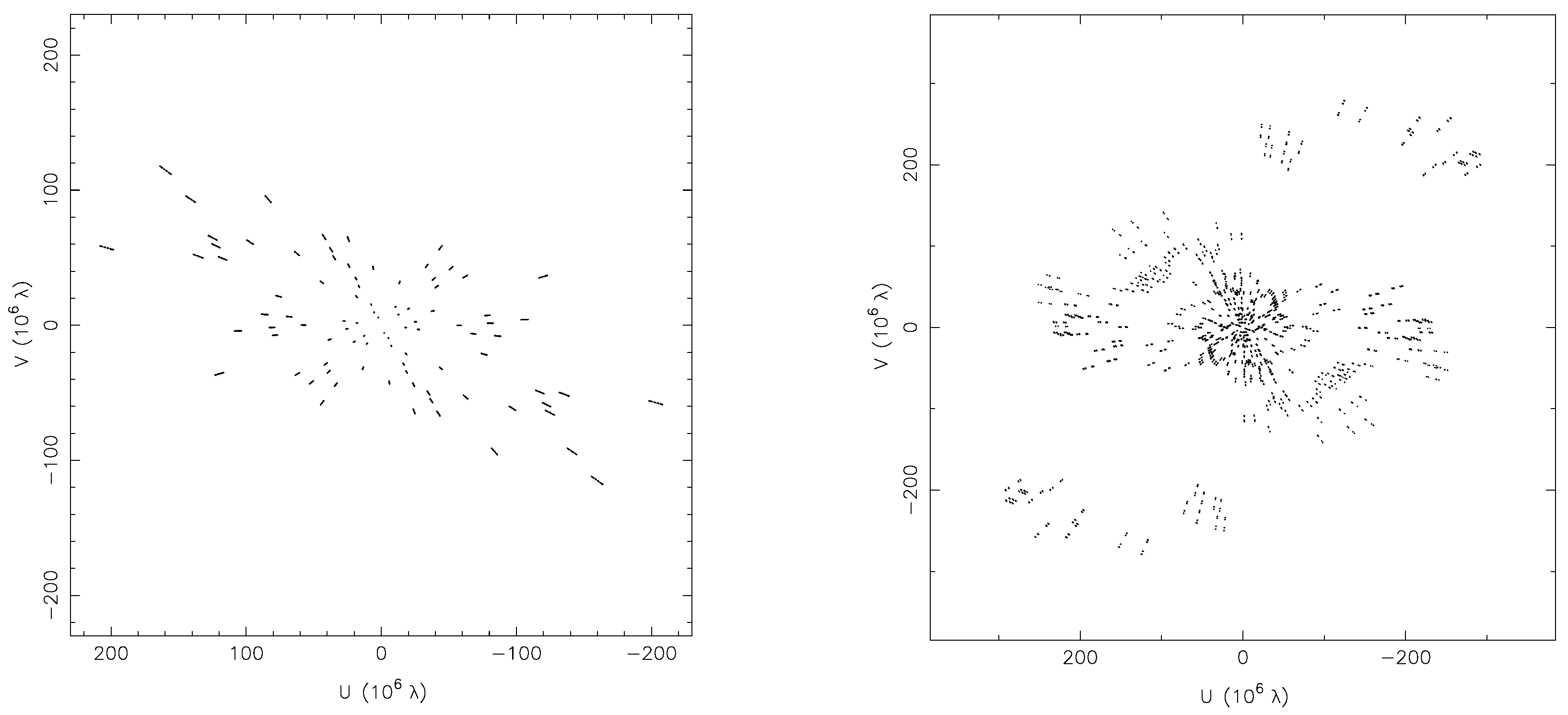
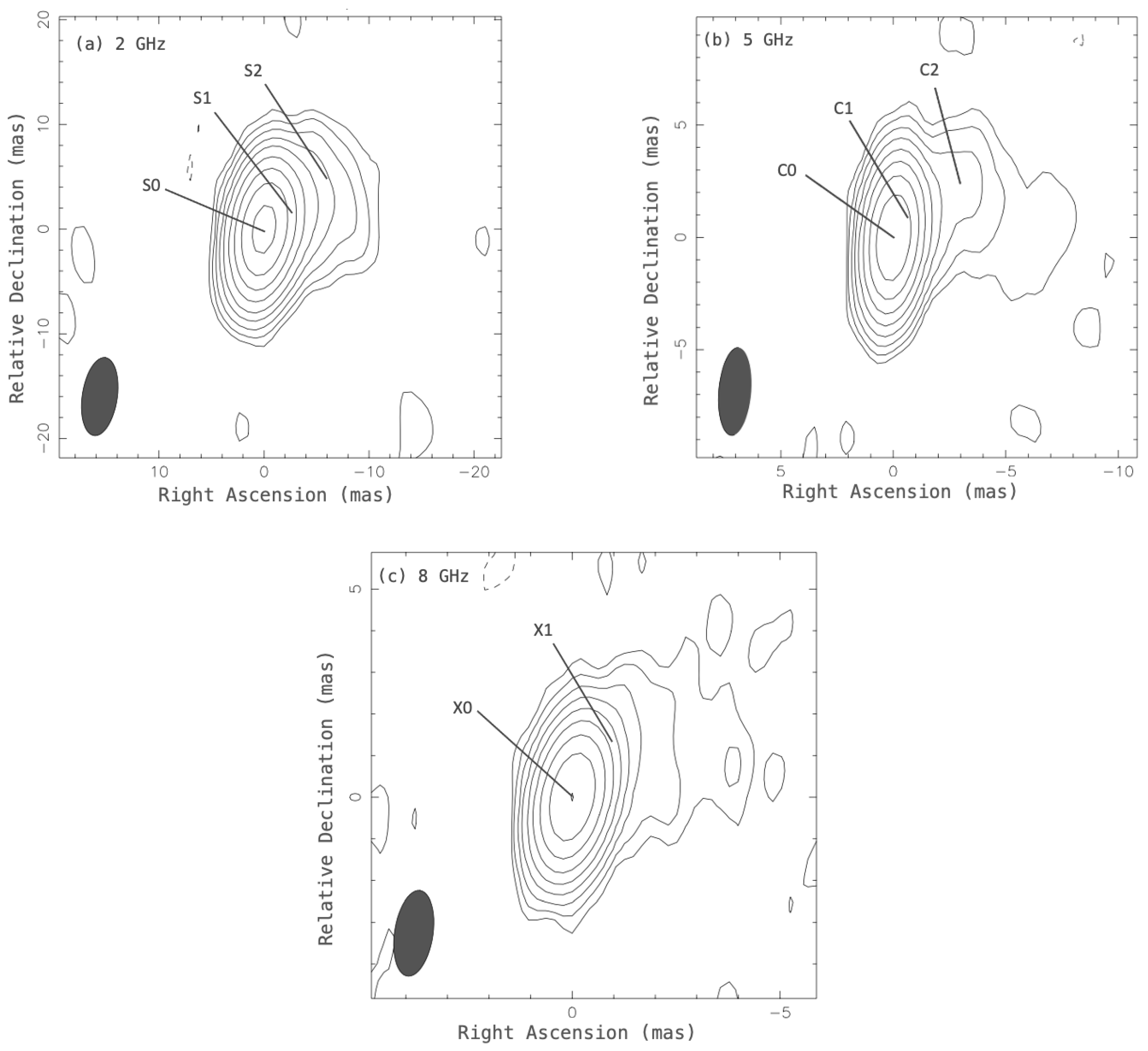
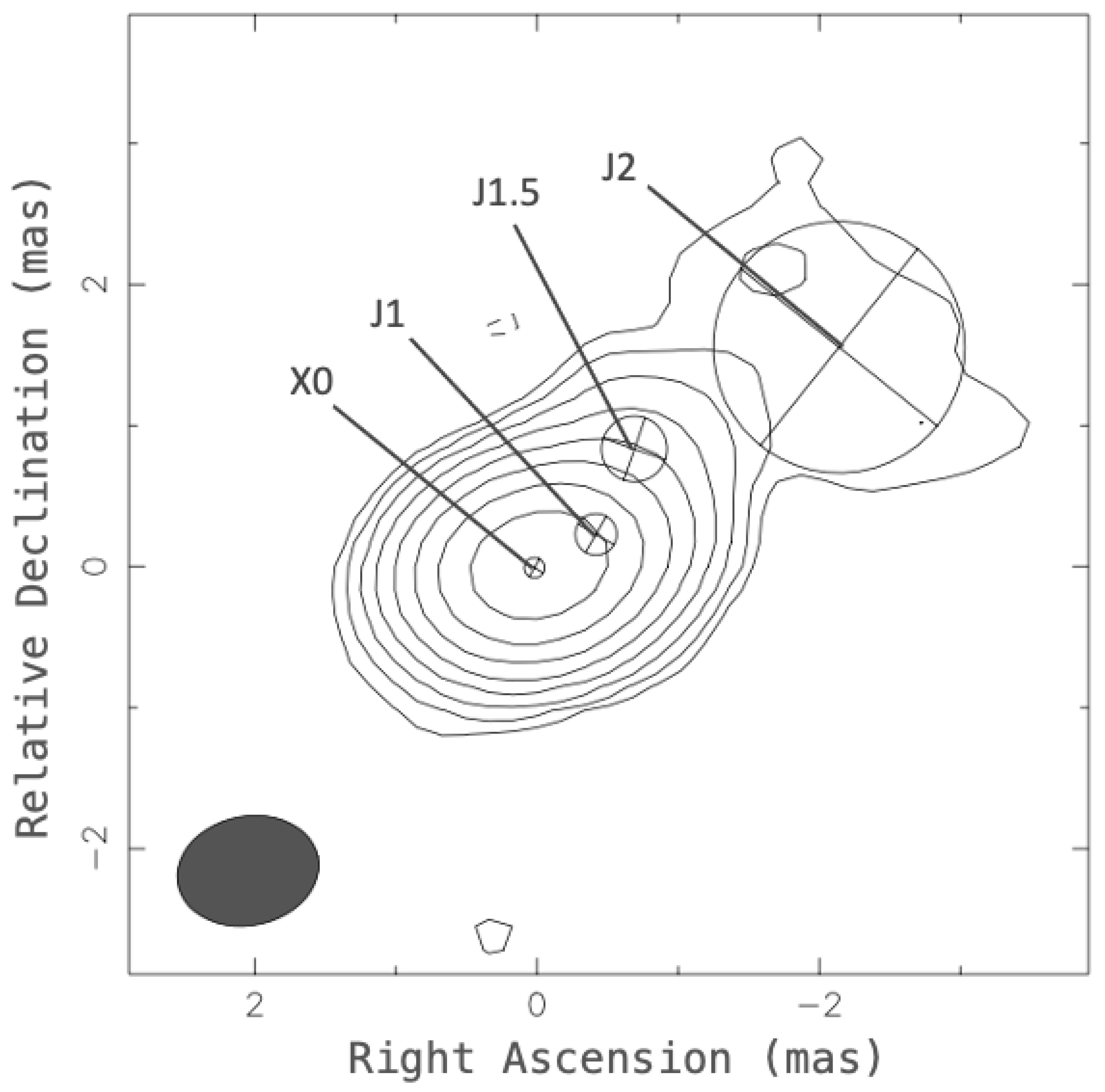
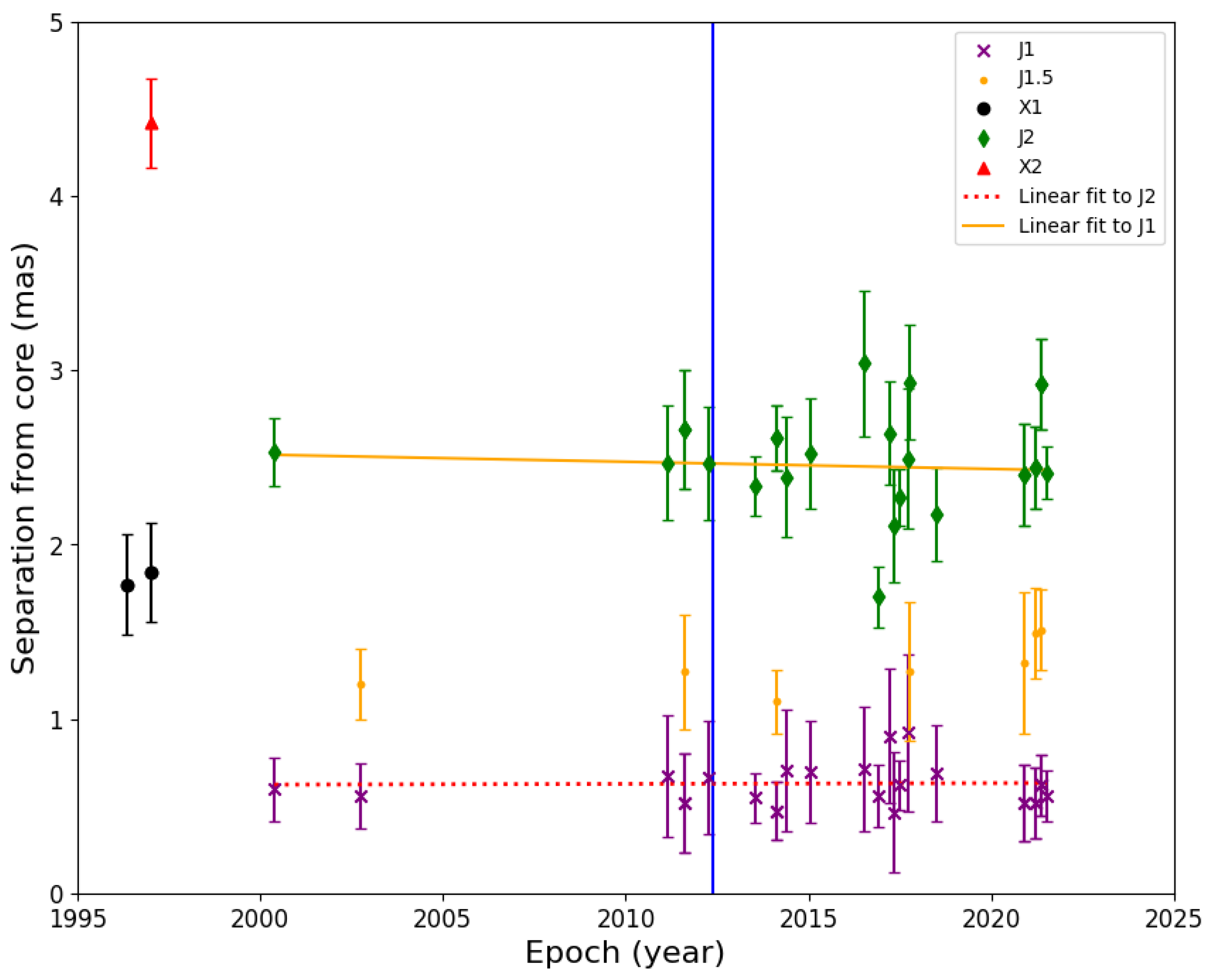
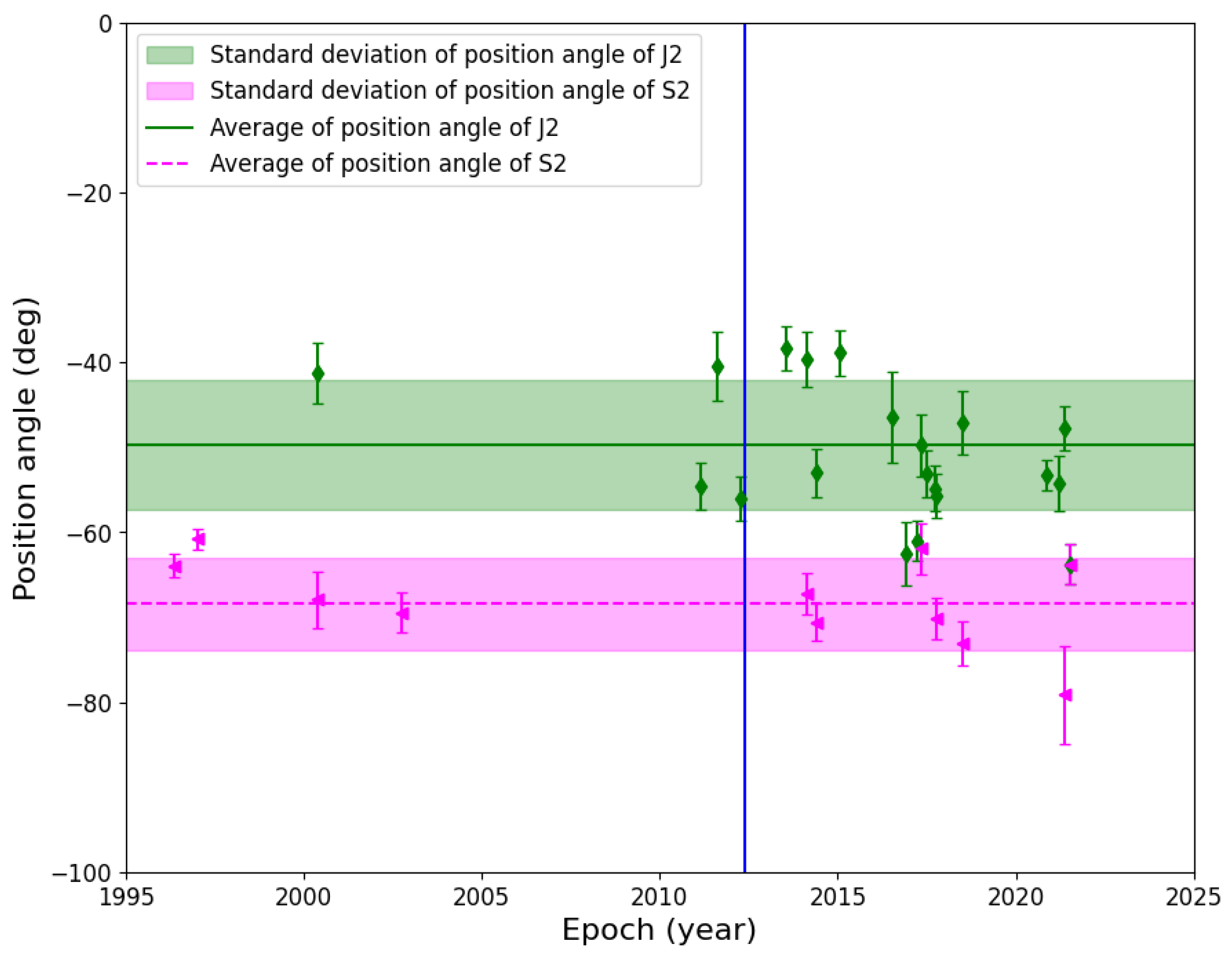


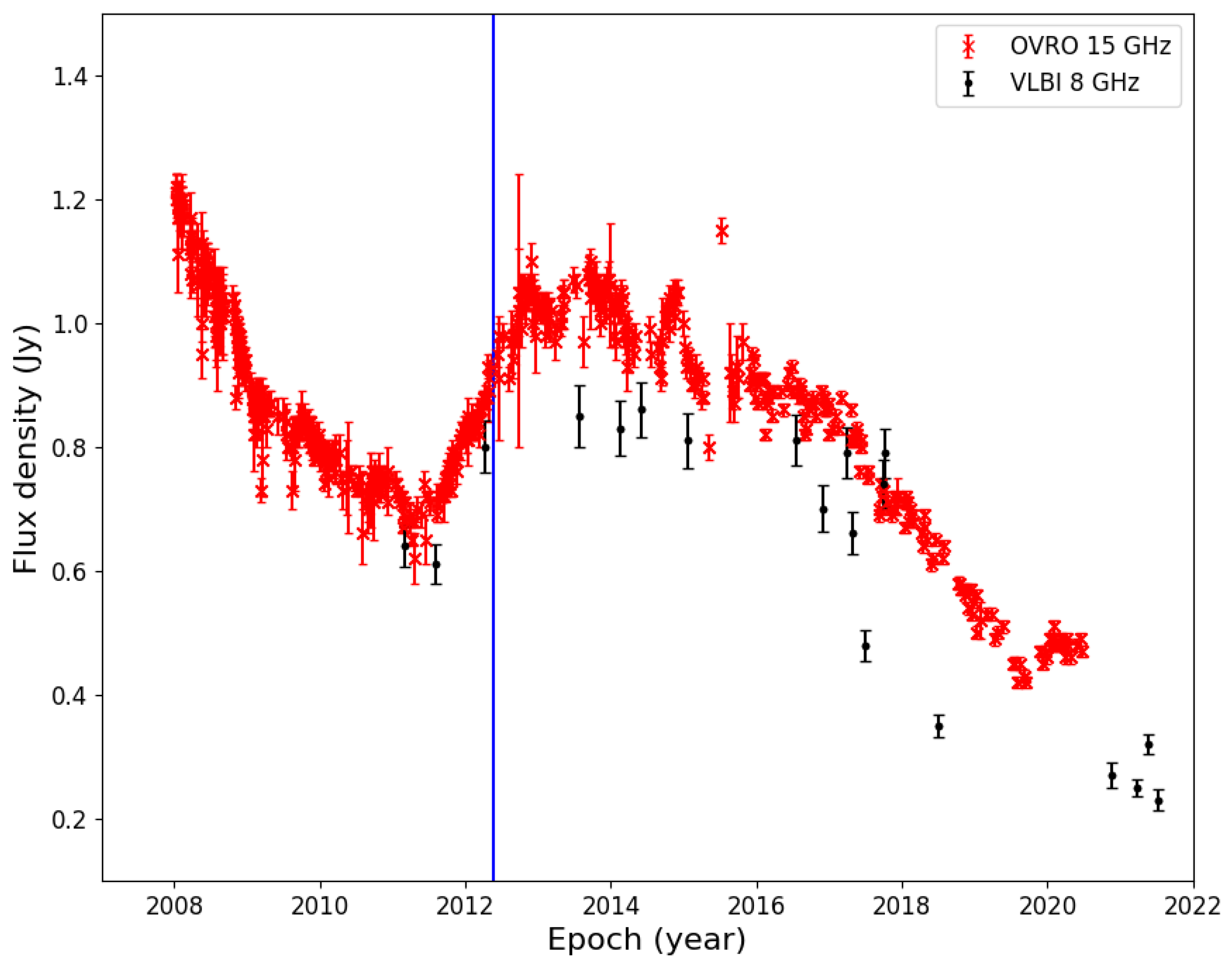
| Epoch | (GHz) | Stations | On-Source Time (s) | IF × BW [MHz] | Refs. |
|---|---|---|---|---|---|
| 1996.05.15. | VLBA | 282 | BB023 [33] | ||
| 1996.06.06. | VLBA | 140 | BH019 [34] | ||
| 1997.01.10. | VLBA | 556 | BF025 [35] | ||
| 2000.05.22. | VLBA, GC, GG, HH, KK, | 1352 | RDV21 [36] | ||
| MA, MC, NY, TS, WF, WZ | |||||
| 2002.09.25. | VLBA, GC, GG, HH, KK, | 1548 | RDV35 [35] | ||
| MA, MC, NY, TS, WF, WZ | |||||
| 2006.02.09. | VLBA | 12,280 | BT085 [37] | ||
| 2011.02.27. | VLBA, HH | 280 | BC196 [38] | ||
| 2011.08.06. | VLBA | 383 | BC196 [38] | ||
| 2012.04.10. | VLBA | 96 | BC201 [38] | ||
| 2013.07.24. | HH, MA, NY, WF, | 17,383 | RV100 | ||
| VLBA −BR, −FD | |||||
| 2014.02.12. | VLBA, HT, MA, | 7259 | RV103 | ||
| NY, ON, WZ | |||||
| 2014.05.31. | VLBA | 609 | BG219 [39] | ||
| 2015.01.23. | VLBA | 25 | BG219 [39] | ||
| 2016.07.17. | VLBA | 56 | BG192 [39] | ||
| 2016.11.30. | VLBA, WZ, HH, ON | 31,760 | RV120 | ||
| 2017.03.27. | VLBA | 14 | UF001 [40] | ||
| 2017.04.28. | VLBA | 37 | UF001 [40] | ||
| 2017.06.28. | VLBA, HH, MC, NY, ON, | 17,352 | RV123 | ||
| YG, WN, WZ | |||||
| 2017.09.26. | VLBA −SC | 47 | UF001 [40] | ||
| 2017.10.09. | VLBA −SC | 35 | UF001 [40] | ||
| 2018.07.05. | VLBA −NL | 119 | UG001 | ||
| 2020.11.18. | HH, ON, WZ, VLBA −SC | 12,892 | RV144 | ||
| 2021.03.24. | ON, SH, WZ, VLBA −MK | 20,238 | RV146 | ||
| 2021.05.19. | VLBA, HH, NS, NY, ON, | 16,018 | RV147 | ||
| SH, WZ | |||||
| 2021.07.07. | NY, VLBA −NL | 4446 | RV148 | ||
Disclaimer/Publisher’s Note: The statements, opinions and data contained in all publications are solely those of the individual author(s) and contributor(s) and not of MDPI and/or the editor(s). MDPI and/or the editor(s) disclaim responsibility for any injury to people or property resulting from any ideas, methods, instructions or products referred to in the content. |
© 2024 by the authors. Licensee MDPI, Basel, Switzerland. This article is an open access article distributed under the terms and conditions of the Creative Commons Attribution (CC BY) license (https://creativecommons.org/licenses/by/4.0/).
Share and Cite
Kőmíves, J.; Gabányi, K.É.; Frey, S.; Kun, E. VLBI Analysis of a Potential High-Energy Neutrino Emitter Blazar. Universe 2024, 10, 78. https://doi.org/10.3390/universe10020078
Kőmíves J, Gabányi KÉ, Frey S, Kun E. VLBI Analysis of a Potential High-Energy Neutrino Emitter Blazar. Universe. 2024; 10(2):78. https://doi.org/10.3390/universe10020078
Chicago/Turabian StyleKőmíves, Janka, Krisztina Éva Gabányi, Sándor Frey, and Emma Kun. 2024. "VLBI Analysis of a Potential High-Energy Neutrino Emitter Blazar" Universe 10, no. 2: 78. https://doi.org/10.3390/universe10020078
APA StyleKőmíves, J., Gabányi, K. É., Frey, S., & Kun, E. (2024). VLBI Analysis of a Potential High-Energy Neutrino Emitter Blazar. Universe, 10(2), 78. https://doi.org/10.3390/universe10020078







